Child Observation Assessment and Professional Experience Report
VerifiedAdded on 2022/11/14
|6
|1432
|164
Report
AI Summary
This report delves into the crucial aspects of child observation and assessment within the realm of early childhood education. It begins by defining child observation as a method of monitoring and evaluating children's behavior during their developmental phase. The report then explores various theoretical perspectives on child development, including operant conditioning by B.F. Skinner, Piaget's stages of cognitive development, and Bandura's Social Learning Theory, highlighting their significance in understanding children's cognitive, social, and emotional growth. Furthermore, it emphasizes the importance of assessment in early childhood education, outlining its purposes, such as demonstrating children's competence, making learning visible, and informing educational planning. The report also connects assessment practices to the Early Years Learning Framework (EYLF), which outlines key learning outcomes. Overall, the report provides a comprehensive understanding of how child observation and assessment contribute to effective early childhood education, offering valuable insights for educators and professionals in the field.
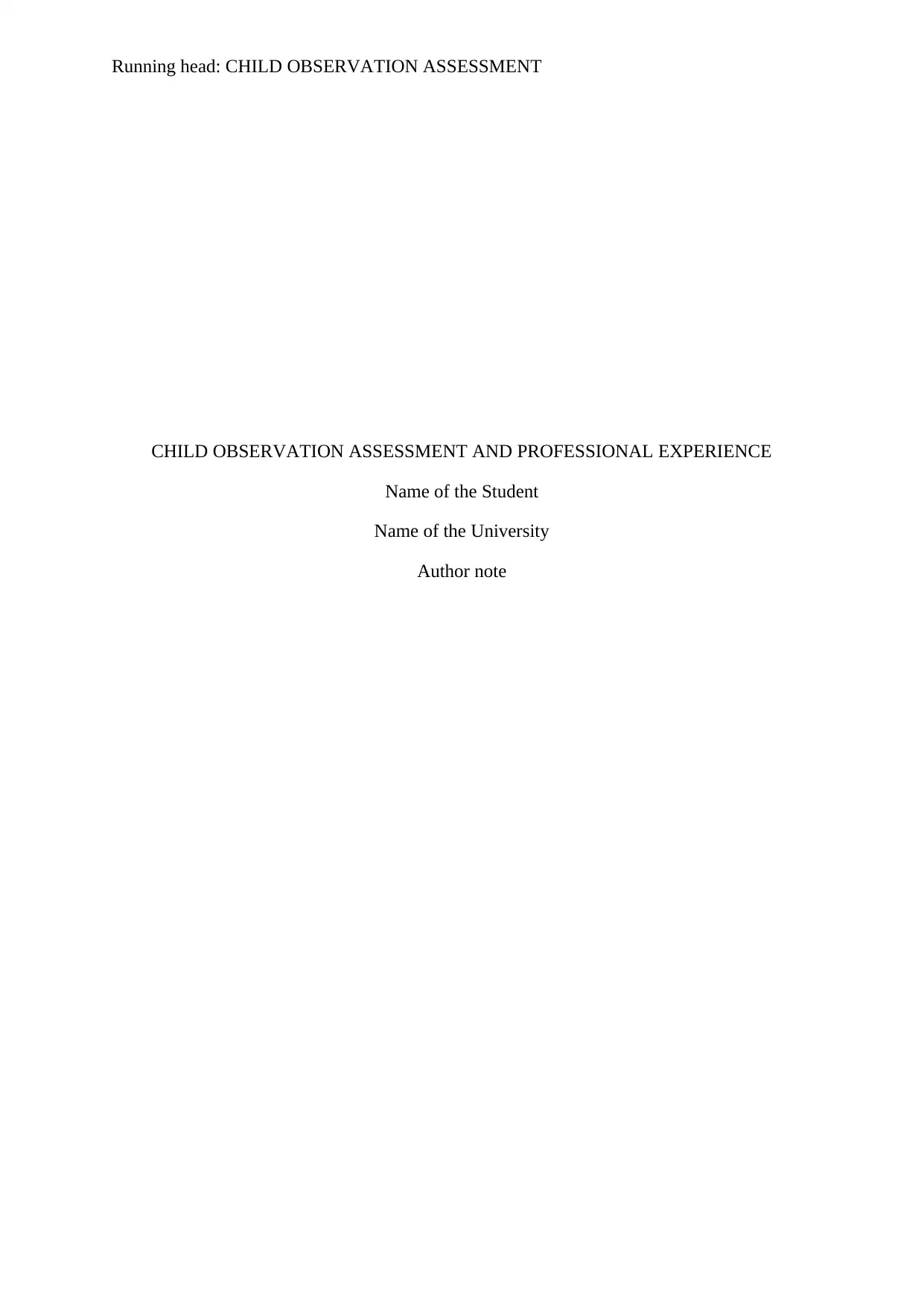
Running head: CHILD OBSERVATION ASSESSMENT
CHILD OBSERVATION ASSESSMENT AND PROFESSIONAL EXPERIENCE
Name of the Student
Name of the University
Author note
CHILD OBSERVATION ASSESSMENT AND PROFESSIONAL EXPERIENCE
Name of the Student
Name of the University
Author note
Paraphrase This Document
Need a fresh take? Get an instant paraphrase of this document with our AI Paraphraser
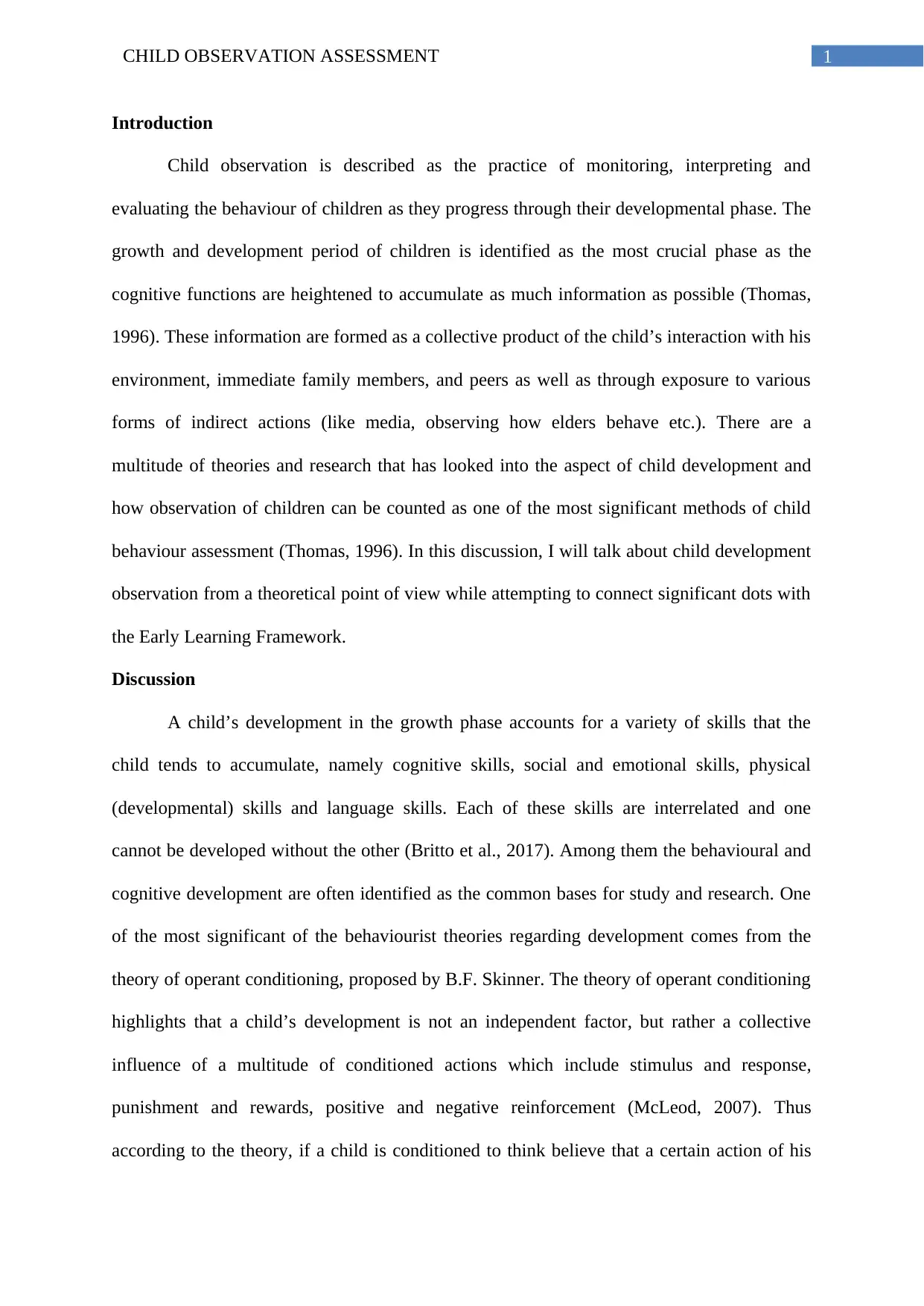
1CHILD OBSERVATION ASSESSMENT
Introduction
Child observation is described as the practice of monitoring, interpreting and
evaluating the behaviour of children as they progress through their developmental phase. The
growth and development period of children is identified as the most crucial phase as the
cognitive functions are heightened to accumulate as much information as possible (Thomas,
1996). These information are formed as a collective product of the child’s interaction with his
environment, immediate family members, and peers as well as through exposure to various
forms of indirect actions (like media, observing how elders behave etc.). There are a
multitude of theories and research that has looked into the aspect of child development and
how observation of children can be counted as one of the most significant methods of child
behaviour assessment (Thomas, 1996). In this discussion, I will talk about child development
observation from a theoretical point of view while attempting to connect significant dots with
the Early Learning Framework.
Discussion
A child’s development in the growth phase accounts for a variety of skills that the
child tends to accumulate, namely cognitive skills, social and emotional skills, physical
(developmental) skills and language skills. Each of these skills are interrelated and one
cannot be developed without the other (Britto et al., 2017). Among them the behavioural and
cognitive development are often identified as the common bases for study and research. One
of the most significant of the behaviourist theories regarding development comes from the
theory of operant conditioning, proposed by B.F. Skinner. The theory of operant conditioning
highlights that a child’s development is not an independent factor, but rather a collective
influence of a multitude of conditioned actions which include stimulus and response,
punishment and rewards, positive and negative reinforcement (McLeod, 2007). Thus
according to the theory, if a child is conditioned to think believe that a certain action of his
Introduction
Child observation is described as the practice of monitoring, interpreting and
evaluating the behaviour of children as they progress through their developmental phase. The
growth and development period of children is identified as the most crucial phase as the
cognitive functions are heightened to accumulate as much information as possible (Thomas,
1996). These information are formed as a collective product of the child’s interaction with his
environment, immediate family members, and peers as well as through exposure to various
forms of indirect actions (like media, observing how elders behave etc.). There are a
multitude of theories and research that has looked into the aspect of child development and
how observation of children can be counted as one of the most significant methods of child
behaviour assessment (Thomas, 1996). In this discussion, I will talk about child development
observation from a theoretical point of view while attempting to connect significant dots with
the Early Learning Framework.
Discussion
A child’s development in the growth phase accounts for a variety of skills that the
child tends to accumulate, namely cognitive skills, social and emotional skills, physical
(developmental) skills and language skills. Each of these skills are interrelated and one
cannot be developed without the other (Britto et al., 2017). Among them the behavioural and
cognitive development are often identified as the common bases for study and research. One
of the most significant of the behaviourist theories regarding development comes from the
theory of operant conditioning, proposed by B.F. Skinner. The theory of operant conditioning
highlights that a child’s development is not an independent factor, but rather a collective
influence of a multitude of conditioned actions which include stimulus and response,
punishment and rewards, positive and negative reinforcement (McLeod, 2007). Thus
according to the theory, if a child is conditioned to think believe that a certain action of his
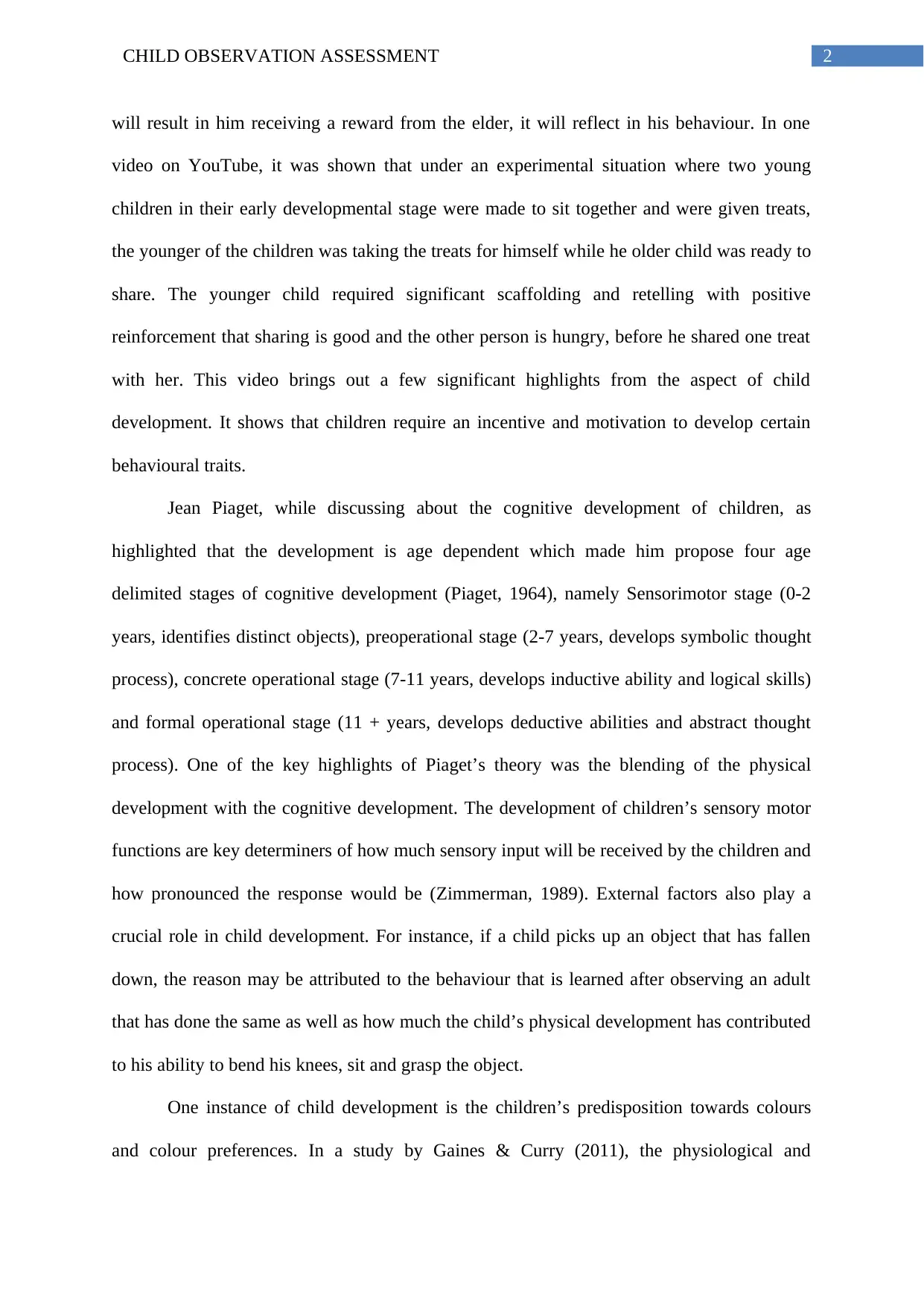
2CHILD OBSERVATION ASSESSMENT
will result in him receiving a reward from the elder, it will reflect in his behaviour. In one
video on YouTube, it was shown that under an experimental situation where two young
children in their early developmental stage were made to sit together and were given treats,
the younger of the children was taking the treats for himself while he older child was ready to
share. The younger child required significant scaffolding and retelling with positive
reinforcement that sharing is good and the other person is hungry, before he shared one treat
with her. This video brings out a few significant highlights from the aspect of child
development. It shows that children require an incentive and motivation to develop certain
behavioural traits.
Jean Piaget, while discussing about the cognitive development of children, as
highlighted that the development is age dependent which made him propose four age
delimited stages of cognitive development (Piaget, 1964), namely Sensorimotor stage (0-2
years, identifies distinct objects), preoperational stage (2-7 years, develops symbolic thought
process), concrete operational stage (7-11 years, develops inductive ability and logical skills)
and formal operational stage (11 + years, develops deductive abilities and abstract thought
process). One of the key highlights of Piaget’s theory was the blending of the physical
development with the cognitive development. The development of children’s sensory motor
functions are key determiners of how much sensory input will be received by the children and
how pronounced the response would be (Zimmerman, 1989). External factors also play a
crucial role in child development. For instance, if a child picks up an object that has fallen
down, the reason may be attributed to the behaviour that is learned after observing an adult
that has done the same as well as how much the child’s physical development has contributed
to his ability to bend his knees, sit and grasp the object.
One instance of child development is the children’s predisposition towards colours
and colour preferences. In a study by Gaines & Curry (2011), the physiological and
will result in him receiving a reward from the elder, it will reflect in his behaviour. In one
video on YouTube, it was shown that under an experimental situation where two young
children in their early developmental stage were made to sit together and were given treats,
the younger of the children was taking the treats for himself while he older child was ready to
share. The younger child required significant scaffolding and retelling with positive
reinforcement that sharing is good and the other person is hungry, before he shared one treat
with her. This video brings out a few significant highlights from the aspect of child
development. It shows that children require an incentive and motivation to develop certain
behavioural traits.
Jean Piaget, while discussing about the cognitive development of children, as
highlighted that the development is age dependent which made him propose four age
delimited stages of cognitive development (Piaget, 1964), namely Sensorimotor stage (0-2
years, identifies distinct objects), preoperational stage (2-7 years, develops symbolic thought
process), concrete operational stage (7-11 years, develops inductive ability and logical skills)
and formal operational stage (11 + years, develops deductive abilities and abstract thought
process). One of the key highlights of Piaget’s theory was the blending of the physical
development with the cognitive development. The development of children’s sensory motor
functions are key determiners of how much sensory input will be received by the children and
how pronounced the response would be (Zimmerman, 1989). External factors also play a
crucial role in child development. For instance, if a child picks up an object that has fallen
down, the reason may be attributed to the behaviour that is learned after observing an adult
that has done the same as well as how much the child’s physical development has contributed
to his ability to bend his knees, sit and grasp the object.
One instance of child development is the children’s predisposition towards colours
and colour preferences. In a study by Gaines & Curry (2011), the physiological and
⊘ This is a preview!⊘
Do you want full access?
Subscribe today to unlock all pages.

Trusted by 1+ million students worldwide

3CHILD OBSERVATION ASSESSMENT
psychological importance of colour was highlighted. The study indicated how different
colour attributes like hue and saturation affect the emotional subsystem of children,
depending on which, they tend to develop an attraction or repulsion towards certain colours.
The study is an important identifier of aspects in child development and early childhood
education where inclusion of colours in a classroom can significantly affect the behavioural
development of children.
Another important highlight in the arena of child development is Albert Bandura’s
Social Learning Theory (Bandura, 1977) which highlights that the development of a child is
heavily reliant on the roles that are played by parents, caregivers, immediate peers as well as
other social influences. It emphasises how children learn to act in a way that is reflective of
their observation.
Observation and Assessment
In the context of childhood development, assessment plays a big role when it comes
to effective early childhood education as well. Assessment can have many forms, ranging
from educational formative and summative assessment to observation, portfolio devises,
record keeping, academic and non-academic documentation etc (Puckett & Black, 2000).
Assessment of child development observation serves three primary purposes. Firstly, it
demonstrates how competent children are, in their achievement as well as how much social,
cognitive, sensorimotor and linguistic skills have developed in the child. Secondly, the
learning in children is made visible to the concerned educators, parents, the caregivers as well
as developmental specialists. Finally, it also helps in the process of further development of
educational plans, targets and outcomes as well as link them to a timeline of development
based on the specific needs and requirements of the children. The Early Years Learning
Framework (EYLF) has highlighted 5 distinct learning outcomes that are crucial for the
development of early childhood educational plan. These outcomes cover all bases of child
psychological importance of colour was highlighted. The study indicated how different
colour attributes like hue and saturation affect the emotional subsystem of children,
depending on which, they tend to develop an attraction or repulsion towards certain colours.
The study is an important identifier of aspects in child development and early childhood
education where inclusion of colours in a classroom can significantly affect the behavioural
development of children.
Another important highlight in the arena of child development is Albert Bandura’s
Social Learning Theory (Bandura, 1977) which highlights that the development of a child is
heavily reliant on the roles that are played by parents, caregivers, immediate peers as well as
other social influences. It emphasises how children learn to act in a way that is reflective of
their observation.
Observation and Assessment
In the context of childhood development, assessment plays a big role when it comes
to effective early childhood education as well. Assessment can have many forms, ranging
from educational formative and summative assessment to observation, portfolio devises,
record keeping, academic and non-academic documentation etc (Puckett & Black, 2000).
Assessment of child development observation serves three primary purposes. Firstly, it
demonstrates how competent children are, in their achievement as well as how much social,
cognitive, sensorimotor and linguistic skills have developed in the child. Secondly, the
learning in children is made visible to the concerned educators, parents, the caregivers as well
as developmental specialists. Finally, it also helps in the process of further development of
educational plans, targets and outcomes as well as link them to a timeline of development
based on the specific needs and requirements of the children. The Early Years Learning
Framework (EYLF) has highlighted 5 distinct learning outcomes that are crucial for the
development of early childhood educational plan. These outcomes cover all bases of child
Paraphrase This Document
Need a fresh take? Get an instant paraphrase of this document with our AI Paraphraser
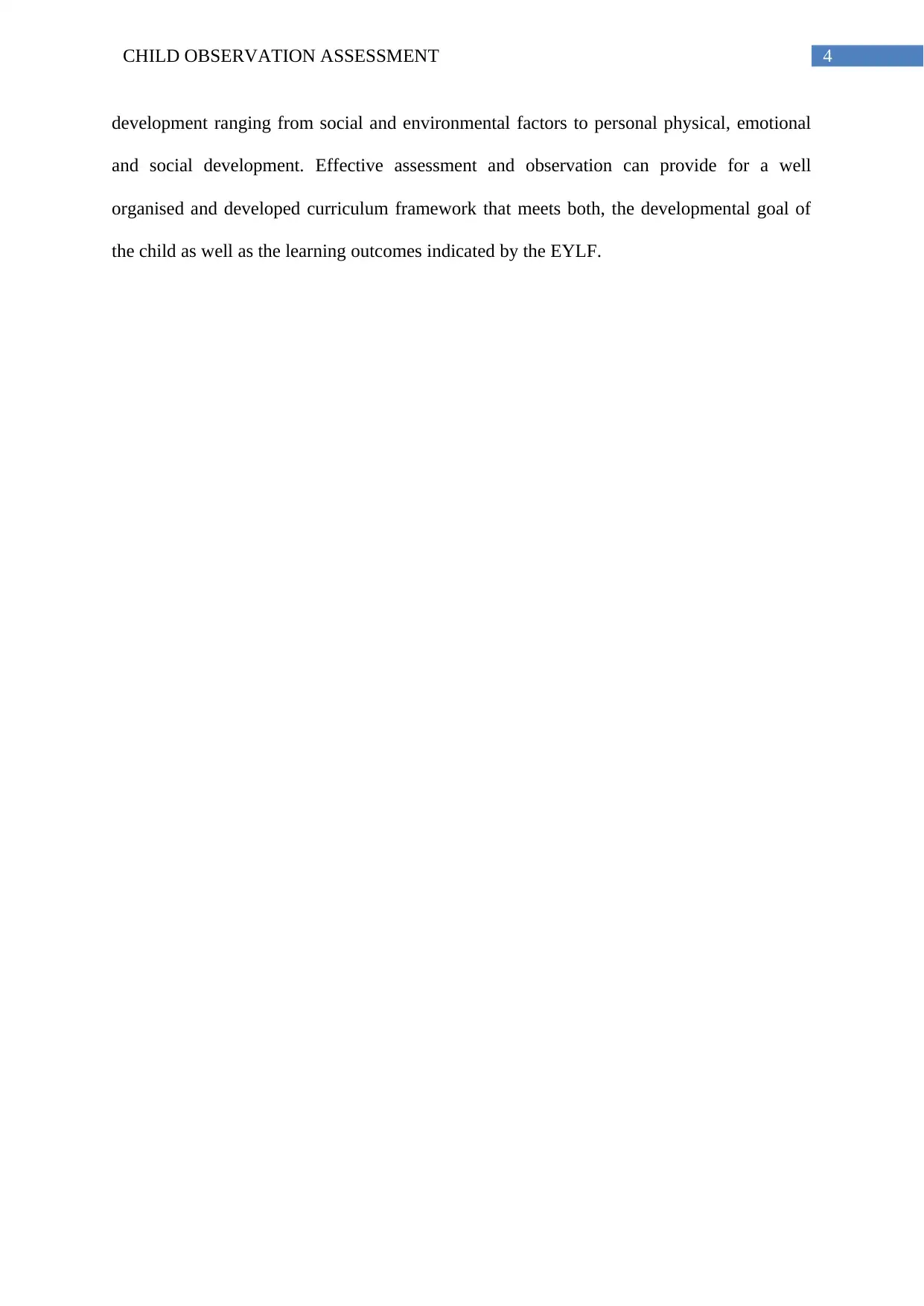
4CHILD OBSERVATION ASSESSMENT
development ranging from social and environmental factors to personal physical, emotional
and social development. Effective assessment and observation can provide for a well
organised and developed curriculum framework that meets both, the developmental goal of
the child as well as the learning outcomes indicated by the EYLF.
development ranging from social and environmental factors to personal physical, emotional
and social development. Effective assessment and observation can provide for a well
organised and developed curriculum framework that meets both, the developmental goal of
the child as well as the learning outcomes indicated by the EYLF.
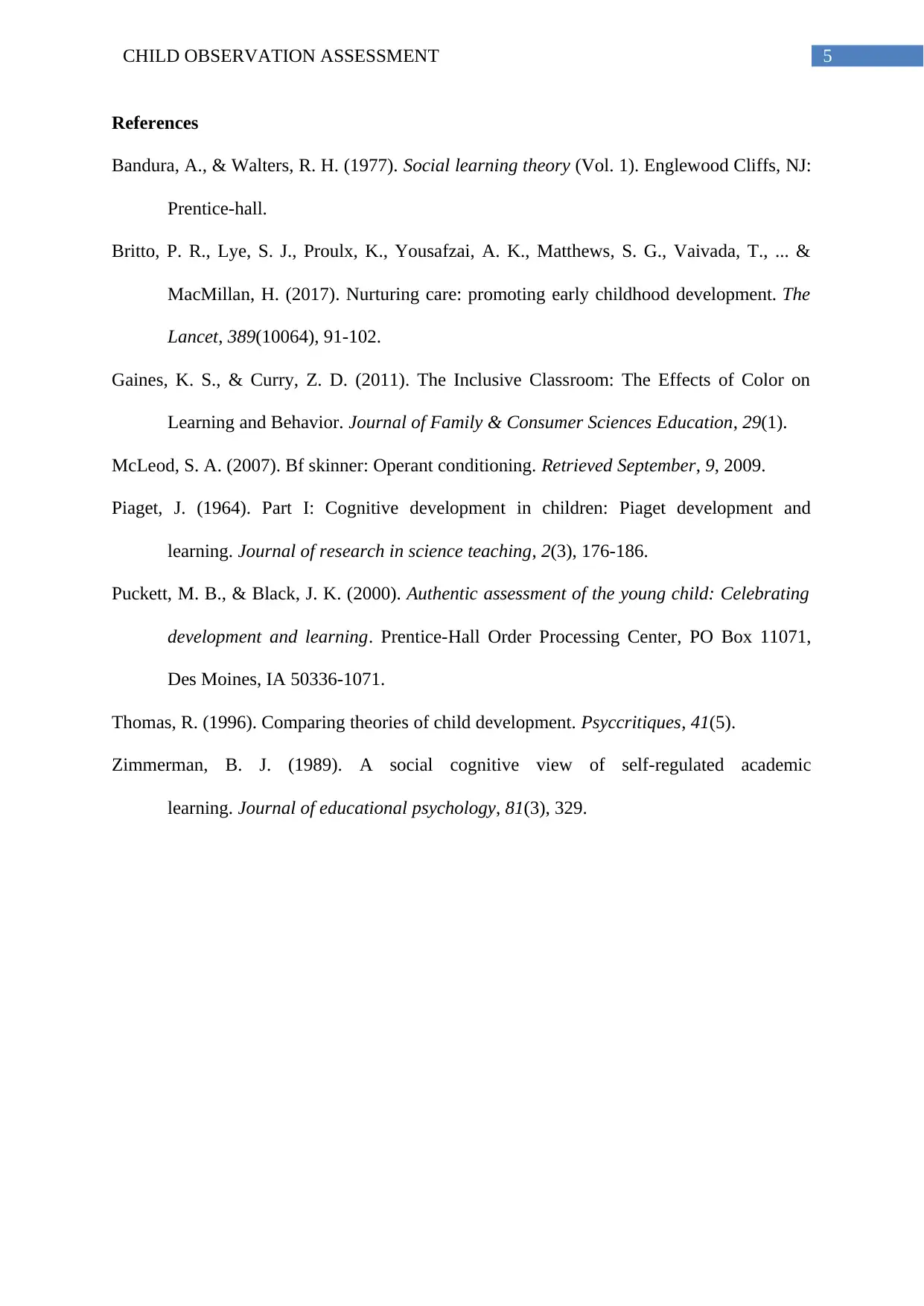
5CHILD OBSERVATION ASSESSMENT
References
Bandura, A., & Walters, R. H. (1977). Social learning theory (Vol. 1). Englewood Cliffs, NJ:
Prentice-hall.
Britto, P. R., Lye, S. J., Proulx, K., Yousafzai, A. K., Matthews, S. G., Vaivada, T., ... &
MacMillan, H. (2017). Nurturing care: promoting early childhood development. The
Lancet, 389(10064), 91-102.
Gaines, K. S., & Curry, Z. D. (2011). The Inclusive Classroom: The Effects of Color on
Learning and Behavior. Journal of Family & Consumer Sciences Education, 29(1).
McLeod, S. A. (2007). Bf skinner: Operant conditioning. Retrieved September, 9, 2009.
Piaget, J. (1964). Part I: Cognitive development in children: Piaget development and
learning. Journal of research in science teaching, 2(3), 176-186.
Puckett, M. B., & Black, J. K. (2000). Authentic assessment of the young child: Celebrating
development and learning. Prentice-Hall Order Processing Center, PO Box 11071,
Des Moines, IA 50336-1071.
Thomas, R. (1996). Comparing theories of child development. Psyccritiques, 41(5).
Zimmerman, B. J. (1989). A social cognitive view of self-regulated academic
learning. Journal of educational psychology, 81(3), 329.
References
Bandura, A., & Walters, R. H. (1977). Social learning theory (Vol. 1). Englewood Cliffs, NJ:
Prentice-hall.
Britto, P. R., Lye, S. J., Proulx, K., Yousafzai, A. K., Matthews, S. G., Vaivada, T., ... &
MacMillan, H. (2017). Nurturing care: promoting early childhood development. The
Lancet, 389(10064), 91-102.
Gaines, K. S., & Curry, Z. D. (2011). The Inclusive Classroom: The Effects of Color on
Learning and Behavior. Journal of Family & Consumer Sciences Education, 29(1).
McLeod, S. A. (2007). Bf skinner: Operant conditioning. Retrieved September, 9, 2009.
Piaget, J. (1964). Part I: Cognitive development in children: Piaget development and
learning. Journal of research in science teaching, 2(3), 176-186.
Puckett, M. B., & Black, J. K. (2000). Authentic assessment of the young child: Celebrating
development and learning. Prentice-Hall Order Processing Center, PO Box 11071,
Des Moines, IA 50336-1071.
Thomas, R. (1996). Comparing theories of child development. Psyccritiques, 41(5).
Zimmerman, B. J. (1989). A social cognitive view of self-regulated academic
learning. Journal of educational psychology, 81(3), 329.
⊘ This is a preview!⊘
Do you want full access?
Subscribe today to unlock all pages.

Trusted by 1+ million students worldwide
1 out of 6
Related Documents
Your All-in-One AI-Powered Toolkit for Academic Success.
+13062052269
info@desklib.com
Available 24*7 on WhatsApp / Email
![[object Object]](/_next/static/media/star-bottom.7253800d.svg)
Unlock your academic potential
Copyright © 2020–2025 A2Z Services. All Rights Reserved. Developed and managed by ZUCOL.





